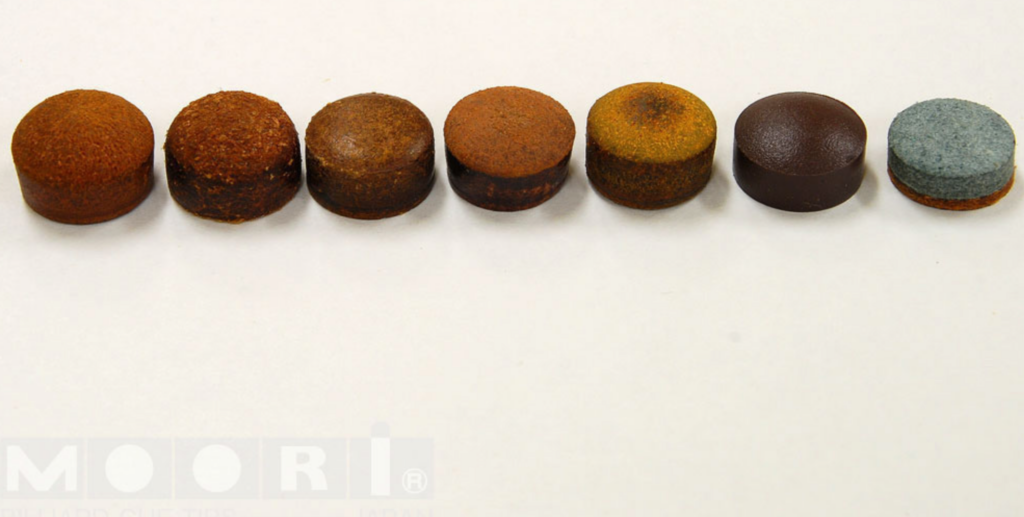Blue leather is “chrome tanning”.
The brown tips are “vegetable tannin-tanned
In this article, we would like to talk about the old fashioned “single leather tip” and “tanning”.
In the course of our research and development, we arrived at the answer to the question of “layering” in a sense of the word “layering” inevitably, as I told you last time.
However, that doesn’t mean that “tips have to be stacked”.
We believe that the single-board tip manufacturers have a great deal to do with the billiard industry, as they have been supplying tips to many billiard fans for a long time.
Blue tips, the so-called “blue type”, are often classified as “fiber” apart from “one piece of leather”.
But this is a mistake.
In fact, they are also made of one piece of leather, just like the brown tips, but different from them in the tanning process.
Blue leather is made of “chrome tanning”, which is the process of transforming the leather into something that will not melt or rot.
On the other hand, brown tips are often made of “vegetable tannin-tanned” leather.
Therefore, it is correct to call them “chrome” and “vegetable tannin” when distinguishing between them.
Incidentally, we use vegetable tannin-tanned leather.
Not only is it sturdy, but it’s
One of the characteristics of chrome tanning is that it is lightly finished
By the way, there is an interesting story about how humans learned how to tan skins.
Once upon a time, a cow fell into a manure pit and drowned to death.
But it was a hassle to pull the dead cows out, so we left them there.
After a long time, we pulled the cow up to use it after skinning and washing it, and found it was much stronger than the leather we used to make by rubbing wild hides.
In the search for the reason why leather is so durable, we discovered that raw hides were transformed into tanning hides by a chemical reaction between animal feces, plant food and grass juice.
It is the origin of vegetable tannin tanning.
In the Middle Ages, various tanning methods were developed and better leather was made in the Middle Ages.
Later, in the middle of the 19th century, a German scientist said, “Vegetable tannin-tanning is smelly, time-consuming and a little heavy. We started our research to see if we could make it possible to tan with more scientific chemicals.
The result was the invention of chrome tanning.
This is revolutionary, not only is it durable, but it is also light.
Besides, as you can see from the tips, vegetable tannin-tanning is hard to color because it turns dark brown, but chrome tanning turns light brown.
That’s why it’s so easy to stain, like the blue ones.
Because of these advantages, chrome tanning quickly overtook vegetable tannin-tanning and spread throughout the world.
Nowadays, probably more than 95% of the leather is made of chrome tanning.
It’s like a dry, alpha-wave.
There was a noiseless sound of a “squeal.
By the way, titanium is now used as a material for golf club wood heads, but in the past, of course, it was wood, and the most suitable material was persimmon.
However, we couldn’t just cut a lot of Persimmon wood, and sooner or later we couldn’t get a good material, so we made a plywood (laminated) head.
This was one of the hints we had in making our laminated tips, but what people who have used Persimmon all their lives lamented when they used plywood is the sound.
It used to make a good sound, but now that it’s plywood, it makes a “squeaky” sound.
The same thing can be said for tips, when you tighten a tip made of a good quality single board leather, like a meat fillet or sirloin, you get a nice alpha sound, a dry “squeal” sound without any noise.
However, it’s difficult to make that sound with a laminated tip because of the sound of the plastic (glue) inevitably getting mixed in.
Our original tips were a little noisy when you played them, and some people said they were annoying, but that’s also why.
As far as today’s tips are concerned, more research has led to fewer people saying they don’t like the sound, but this is still an issue.
The leather I was looking for when I was prototyping the tip was bullfighting bull hide.
If I could get a good veneer leather now, I’d be more confident than the good veneer tips I’ve had in the past.
The leather I was looking for when I was prototyping the tips was bullfighting leather.
When you weigh a ton, the skin is also very strong because it’s grown and muscular, especially when it comes to the waist area.
That would have been about 17 or 18 years ago now.
It’s exactly like “This! There was a time when we were sent two handfuls of exquisite leather called
So we quickly made a few hundred tips out of that leather, and they were as good as or better than the luxury products we had in the past.
All the professional players who have tried it can’t help but say it’s the best.
But as I mentioned last time, that leather was at a “can be” level and was no longer coming in.
In other words, we had the technology to make good quality tips, but we couldn’t make them even if we wanted to because we didn’t have the materials.
I think it’s very rare to find such leather in the future, and even more so when it’s in stable supply.
In that sense, the opportunity to enjoy the unique qualities of a single-plate tip has become very rare, and I regret that.




